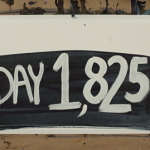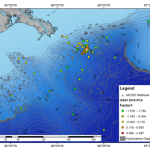Once again this week, NPR was subtly poking us all with a stick—“Hey, remember that oil spill that happened last year?” I love NPR.
‘Fog Of Research’ Clouds Study Of Oil’s Effects In Gulf
This story really hit home, because I’ve been personally dealing with many of the frustrations mentioned in this report. There really is no large-scale coordination of the continuing scientific effort in the Gulf. As the story duly notes, “The real gumshoe work is just beginning”
I’ve consistently lamented about our difficulty obtaining critical post-spill sediment samples (despite thousands being collected). NPR also points this out—most government research (i.e. NOAA’s 393920202 samples) is unfortunately restrained by the ‘oil pollution act’. This means that ongoing research is kept secret due to pending litigation. Everything is kept tightly under wraps, and us academics are completely in the dark—we have no idea what they are doing (specific tests, hypotheses, or questions), and because of this secrecy there may be gaping holes and serious gaps in oil spill research. Right now, there is no peer review from the wider community.
This also affects the public’s perception of the lasting impacts—if people don’t have information, then it automatically feeds their fears. Seafood safety is one prime example.
Then there’s the money. Or rather, there isn’t the money. Only $50 million of BP’s promised $500 million in research money has been doled out; a scientific board has been set up to distribute the remaining $450 million, but it seems like they’re still writing ethical guidelines and drafting up an application process. Which means, probably another year before any scientists will be able to use money from this pot.
But timing is critical, and right now the timing couldn’t be worse. We’re coming close to spring in the Gulf, where life will bloom and the lingering effects of oil may suddenly manifest.
[Christoper D’Elia from LSU notes that] “…one of the big issues that I’m concerned about is what is going to happen to the food chains — the food webs off the coast of Louisiana in particular — where the oiling was the heaviest.”
Scientists such as Don Boesch, who sits on the official Oil Spill Commission…says the slow start has already compromised the research effort “because we had much more limited effort to go out and actually describe the effects of the spill and track the oil when it was actually coming out of the bottom of the gulf.”
RAPID response grants from the National Science Foundation only last a year. Ours expires in July. Our research is nowhere near finished, and I can’t afford to work for free. I need to go on another sampling trip to investigate potential seasonal variation in communities, but grant money is already tight.
Gulf Spill Investigated As Cause Of Dolphin Deaths
I don’t posess an undying love for the rats of the sea, but this headline definitely caught my attention.
There’s been a slew of dolphin deaths lately—67 washed ashore in Louisiana, Mississippi, and Alabama. Most of these were infants—stillborn and premature calves, as well as some that apparently died shortly after birth.
We’ll have to wait for conclusive causes of death—tests are currently being carried out—but the timing of these deaths is interesting. The dead calves would have been conceived directly prior to the BP spill, gestating and developing as the oil was gushing.
Did the mothers eat oil-contaminated fish that poisoned their young? Did the calves fall prey to an infectious disease? Was it just a particularly cold winter? Was there a toxic algal bloom?
Stay tuned for next week’s episode of CSI: Gulf of Mexico
Panel Pushes Back Delivery Of Gulf Oil Spill Report
For those of you on the edge of your seats, you’ll now have to wait a little while longer to find out what really went wrong with the infamous blowout preventer—July now, instead of April. But it seems we will at least get a sneak peek of the findings in April when the joint Coast Guard-Ocean Energy Management and Regulation panel issues a preliminary statement.






Have to agree with you. We had a mobile bio-remed plan in place last year when oil was washing up on beaches and spent four months getting “ground down” by red tape, red flags, and red necks in the region, many of which were with the Dept of Homeland.
We pulled the project with the ability to brew 500,000 gal of oil munching bac a week using waste oil from local fryers after a Homeland Hoss in the region looked over our mobile reactor specs and declared, “that there bio truck looks just like the ones Sa-Dam had in I-Rac”.
Where the hell do you go from there?
Our team decided it was just not worth trying to save anything in the Gulf, rather let a geologic time scale tale care of the mess.
Sadly, and I am NO FAN of Jane Lubchenco, it would seem that NOAA is more interested in geologic time scale results as well.
We wasted a lot of time and money on that project just wanting to help out the local region and the wildlife, it was a real eye opener.
The next time this happens we’ll suggests to anyone who cares to listen, don’t even bother trying because those who donate to the campaign coffers do not want anyone helping out, and those who’s campaign coffers get filled only pull the levers of power after they get a handwritten note from the money guys.
The note reads, “Do nothing, block everything, and only say what we want you to say, because 5000 barrels a day sure sounds better than 25,000 barrels a day”.
Thank you again Dr. Bik for keeping the disaster in mind.
Through a partnership with the Surfrider Foundation, Patagonia, USF Geologist Rip Kirby, and individual donors, we have gone where the Unified Command and local government refuses to go. http://www.SurfriderEmeraldCoast.org for more about our testing efforts.
It has been excruciatingly slow, but we have developed several methods for identifying Corexit and oil contamination on our beaches. We are using high power UV lights to spot contamination, IR/MS to fingerprint the Corexit sulfur isotope, and GC/MS to identify and quantify the PAH’s. We are working to develop scale for field quantification of the degree of contamination for individual samples. BP still uses only a visual determination (<1% surface oiled and no tarballs over 1cm) to certify beaches as clean. What they mean is out of sight, out of mind. We have areas where the contaminated soil has been ground down and mixed to depths of three feet. These form uniformly contaminated layers of small particles invisible to the naked eye in white light, but glowing brightly under UV.
One thing we have learned for certain during this disaster is that if you wait for the government to make things right, you can expect to wait a long time. With that in mind, our volunteers are available to take samples for any sincere researcher who needs someone on the ground down here.